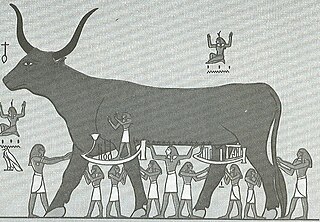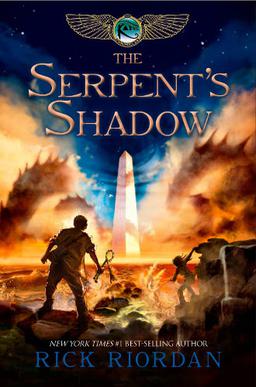
The Osiris myth is the most elaborate and influential story in ancient Egyptian mythology. It concerns the murder of the god Osiris, a primeval king of Egypt, and its consequences. Osiris's murderer, his brother Set, usurps his throne. Meanwhile, Osiris's wife Isis restores her husband's body, allowing him to posthumously conceive their son, Horus. The remainder of the story focuses on Horus, the product of the union of Isis and Osiris, who is at first a vulnerable child protected by his mother and then becomes Set's rival for the throne. Their often violent conflict ends with Horus's triumph, which restores maat to Egypt after Set's unrighteous reign and completes the process of Osiris's resurrection.

Set is a god of deserts, storms, disorder, violence, and foreigners in ancient Egyptian religion. In Ancient Greek, the god's name is given as Sēth. Set had a positive role where he accompanied Ra on his barque to repel Apep (Apophis), the serpent of Chaos. Set had a vital role as a reconciled combatant. He was lord of the Red Land (desert), where he was the balance to Horus' role as lord of the Black Land.

Khonsu is an ancient Egyptian god of the Moon. His name means 'traveller', and this may relate to the perceived nightly travel of the Moon across the sky. Along with Thoth, he marked the passage of time and is associated with baboons. Khonsu was instrumental in the creation of new life in all living creatures. At Thebes, he formed part of a family triad with Mut as his mother and Amun his father.

Nehebkau was the primordial snake god in ancient Egyptian mythology. Although originally considered an evil spirit, he later functions as a funerary god associated with the afterlife. As one of the forty-two assessors of Ma’at, Nehebkau was believed to judge the deceased after death and provide their souls with ka – the part of the soul that distinguished the living from the dead.

Senet or senat is a board game from ancient Egypt that consists of ten or more pawns on a 30-square playing board. The earliest representation of senet is dated to c. 2620 BCE from the Mastaba of Hesy-Re, while similar boards and hieroglyphic signs are found even earlier, including in the Levant in the Early Bronze Age II period. Even though the game has a 2,000-year history in Egypt, there appears to be very little variation in terms of key components. This can be determined by studying the various senet boards that have been found by archaeologists, as well as depictions of senet being played throughout Egyptian history on places like tomb walls and papyrus scrolls. However, the game fell out of use during the Roman period, and its original rules are the subject of conjecture.
Book of Thoth is a name given to many ancient Egyptian texts supposed to have been written by Thoth, the Egyptian god of writing and knowledge. They include many texts that were claimed to exist by ancient authors and a magical book that appears in an Egyptian work of fiction.
The Book of Gates is an ancient Egyptian funerary text dating from the New Kingdom. The Book of Gates is long and detailed, consisting of one hundred scenes. It narrates the passage of a newly deceased soul into the next world journeying with the sun god, Ra, through the underworld during the hours of the night towards his resurrection. The soul is required to pass through a series of 'gates' at each hour of the journey. Each gate is guarded by a different serpent deity that is associated with a different goddess. It is important that the deceased knows the names of each guardian. Depictions of the judgment of the dead are shown in the last three hours. The text implies that some people will pass through unharmed, but others will suffer torment in a lake of fire. At the end of Ra's journey through the underworld, he emerges anew to take his place back in the sky.

The Coffin Texts are a collection of ancient Egyptian funerary spells written on coffins beginning in the First Intermediate Period. They are partially derived from the earlier Pyramid Texts, reserved for royal use only, but contain substantial new material related to everyday desires, indicating a new target audience of common people. Coffin texts are dated back to 2100 BCE. Ordinary Egyptians who could afford a coffin had access to these funerary spells and the pharaoh no longer had exclusive rights to an afterlife.

QV44 is one of several tombs located in the Valley of the Queens intended for the use of Ramesses III's sons. The painted reliefs decorating Khaemwaset E's tomb illustrate his ritual and symbolic journey in the Afterlife as he meets the main gods of that region as well as the genies who guard the gates of the kingdom of Osiris.
Prince Khaemweset was the fourth son of Ramesses II and the second son by his queen Isetnofret. His contributions to Egyptian society were remembered for centuries after his death. Khaemweset has been described as "the first Egyptologist" due to his efforts in identifying and restoring historic buildings, tombs and temples.

The Book of Caverns is an important ancient Egyptian netherworld book of the New Kingdom. Like all other netherworld books, it is also attested on the inside of kings’ tombs for the benefit of the deceased. It describes the journey of the sun god Ra through the six caverns of the underworld, focusing on the interaction between the sun god and the inhabitants of the netherworld, including rewards for the righteous and punishments for the enemies of the worldly order, those who fail their judgment in the afterlife. The Book of Caverns is one of the best sources of information about the Egyptian concept of hell.

The Graffito of Esmet-Akhom, also known by its designation Philae 436 or GPH 436, is the last known ancient Egyptian inscription written in Egyptian hieroglyphs, carved on 24 August 394 AD. The inscription, carved in the temple of Philae in southern Egypt, was created by a priest named Nesmeterakhem and consists of a carved figure of the god Mandulis as well an accompanying text wherein Nesmeterakhem hopes his inscription will last "for all time and eternity". The inscription also contains a text in the demotic script, with similar content.

The Book of the Earth is an Ancient Egyptian funerary text that has been called many names such as The Creation of the Sun Disk and the Book of Aker. The Book primarily appears on the tombs of Merneptah, Twosret, Ramesses III, Ramesses VI, and Ramesses VII and serves as a counterpart to the Book of Caverns.

The Book of the Heavenly Cow, or the Book of the Cow of Heaven, is an Ancient Egyptian text thought to have originated during the Amarna Period and, in part, describes the reasons for the imperfect state of the world in terms of humankind's rebellion against the supreme sun god, Ra. Divine punishment was inflicted through the goddess Hathor, with the survivors suffering through separation from Ra, who now resided in the sky on the back of Nut, the heavenly cow.

Tyti was an ancient Egyptian queen of the 20th Dynasty. A wife and sister of Ramesses III and possibly the mother of Ramesses IV.

The Serpent's Shadow is a 2012 fantasy adventure novel based on Egyptian mythology written by American author Rick Riordan. It is the third and final novel in The Kane Chronicles series. It was published by Disney Hyperion on May 1, 2012.
"The Quarrel of Apophis and Seqenenre" is an ancient Egyptian story. It is fragmentarily attested only in a papyrus copy made by a scribe named Pentawer during the reign of pharaoh Merenptah of the 19th Dynasty. The story is set in an earlier date, towards the end of the Second Intermediate Period: the main characters are the two pharaohs Apophis and Seqenenre Tao, though the text is not historically accurate. In it, 'the Hyksos king Apophis challenges Seqenre, the local ruler of Thebes, with an adynaton [puzzle]. The end of the tale has been lost, but Seqenenre presumably found a solution, perhaps with the help of a wise counsellor.' It is part of a wider corpus of ancient Egyptian tales of wisdom-contests: it has some similarities, for example, to the much later "Tale of Setne Khamwas and Si-Osire", attested on papyrus in the Roman period.

The Cavern deities of the underworld were ancient Egyptian minor deities charged with punishing the damned souls by beheading and devouring them.

Hor son of Punesh is a magician from ancient Egyptian literature.















